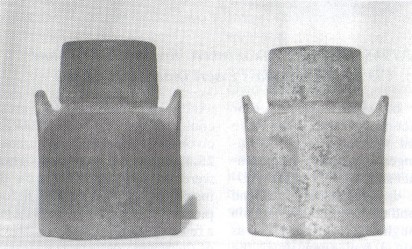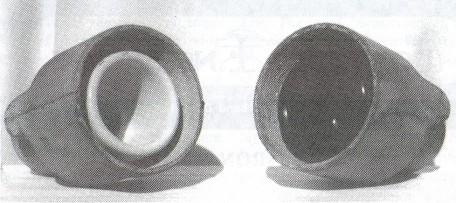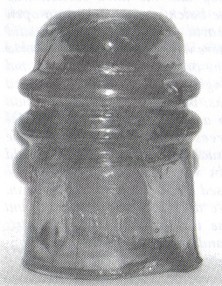Foreign Insulators
by Marilyn Albers
Reprinted from "Crown Jewels of the Wire", June 1994, page 17
THE "IRON MEN"
This pair of insulators are aptly nicknamed the "Iron Men", because
the outer shells are made of cast iron, and they closely resemble the French
style we refer to as the "gingerbread man". At first glance, you'll
think they are identical, so why the different classification numbers? The
reason for this is that the insulator on the left has a porcelain inner skirt
and that on the right has one of green glass! Both inserts are held in place
with cement. Now just where would you put them in the foreign style charts?
Would you put them there at all? This is sort of like catching two fish, one
covered with feathers and the other with fur, but they are still fish!

The "Iron Men" U-1965B (left) and CD 649 (right)
Jack
Tod had a solution. When he and I were putting together the 1986 Supplement of
Worldwide Porcelain Insulators and scale drawings were being made of new styles,
there were several insulators. with iron shells and porcelain inner skirts
included in the well known Keith Neal collection (Guernsey, Channel Islands).
Even though they were a mixture of materials, Jack hated to leave them out of
the U-Chart because of their rarity and their definite place in the
history of worldwide insulator manufacturing. So he made a space for them and
the unmarked ironclad gingerbread man with porcelain inner skirt was classified
as U-1965B. In 1981, a family friend had found this insulator in Tunisia and
brought it back as a gift. It was the only I had seen until the Metroplex show
in Grapevine, Texas, March 26th of this year. Amazing insulators have turned up
at this annual show!

U-1965B with porcelain insert inner skirt (left) and
CD 649 with a glass
insert inner skirt (right)
As I was setting out my sales stock that day, a collector
asked me if I had seen the foreign insulators on Ron Haglund's table. A fast trip
around the corner put me in front of three large gingerbread men, including one
unmarked white porcelain (U-2057) and two of glass (CD 642) with familiar French
embossings. The fourth piece was an ironclad gingerbread man! Just finding
another of these was exciting, but when I turned it over my heart skipped a
beat. The inner skirt was made of green glass! It was fairly dirty, but I took
it to the window and reading backwards I could make out the word ISOREX on one half-mold
and the numbers 25.41 on the opposite half. There were no other markings on the
insulator. Ron told me that all four pieces had come out of Tunisia just a few
days before the show. Three of them were definitely of French manufacture, which
tells us that Tunisia probably relied heavily on imported insulators for local
use, if indeed there were any insulator factories in this country at all. The
glass insert of the iron clad piece was made before 1959 by a manufacturer in
the city of Reims called Nord-Verre. "ISOREX" was the official
company trademark used on glass insulators. Quite possibly "41 " is
the date of manufacture, but there is no way to be sure. Siemens Brothers &
Co., Ltd. of London may have supplied the cast iron shells for both of the Iron
Men, since their 1910 catalog offered several styles of "Iron Hooded"
insulators.
It was a little harder to convince Woody that this insulator needed a CD number. He was diametrically
opposed to including it in a CD Style Chart of glass insulators and this is
certainly understandable. But since the precedent had already been set by Jack's
saving a place in the Universal Style Chart for ironclad insulators with
porcelain inner skirts, Woody finally agreed to classify this new find as CD
649, but he is still shaking his head.
THE "P.M.G." INSULATOR

CD 121 "P.M.G."
CD 121 is not an uncommon insulator style, but I seriously doubt if any of
you have seen one embossed "P.M.G" (Post Master General). I have not
actually seen
this piece either, but when husband Bill and I made our trip to Australia in
the fall of '93, we had a good visit with Brian Woodman, a collector from Corio,
Victoria (See February 1994 issue of Crown Jewels). He has definitely seen this
insulator, and though he doesn't own it, he would like to, and all his fingers
and toes are crossed. The owner is very protective of it, but did allow Brian to
take a photo, which in turn was sent to me along with the negative. The
"P.M.G." is an extremely rare piece in that it is one of only six
known to have survived, all of which are of the same light blue glass. These six
are loved and treasured by relatives of the man whose company produced a limited
number of them sometime between 1912 and 1915, the four years the factory was in
operation. Thanks to Brian, we do have some historical information on this
insulator, though he has not told me the exact source. The material is rather
extensive, so I have condensed much of it, but in order to avoid losing some of
the flavor, two sections are quoted directly. These you will find in italics.
Edward L.R. Roberts was born in England in 1864. He was the oldest son of the
late Mr. Edward Robert of Kent, England, a distinguished English astronomer who
was decorated by King Edward VII for his work in connection with the invention
of a "time-predicting machine", used extensively by the government of
the day. His mother was a member of the well-known family of Wedgewood, who were famous potters, and one of his aunts
was married to the eminent scientist, Charles Darwin. Edward the younger
studied medicine for a time, but soon gave that up to train as an industrial
chemist and became involved in the manufacture of glass in Scotland and England.
He followed a family tradition, as several generations before him had been
glassmakers.
Edward came to Australia in 1889 at the age of
twenty-five. He opened
a business on Flinders Street in Melbourne and was employed by a number of firms
interested in the manufacture of glass. There he fell in love with his first
cousin Jessie Alger, whom he first met when she visited England at age sixteen.
They' were married in 1891 and for several years Melbourne was their home. Part
of that time, Edward was employed by Brooks Robinson, well known makers of
stained glass, who were responsible for many beautiful Church windows.
The
family eventually moved to Lake Tyers where Edward managed the Lake Tyers
"Guest House". In 1902, at age 31, Jessie Roberts died, leaving her
husband with three sons, Gilbert (age 8), Herbert (age 6), Stanley (age 4) and a
daughter Jessie (age 1). Edward took the children and went back to England.
After two years there, they returned to Lake Tyers, a place they had all come to
love. In 1908 Edward was married a second time, this time to Emma Curtis, by
whom he had one son, John Arthur, born in 1916.
About the time of his second
marriage, Edward received a large sum of money from his father and established a glassworks on the shores of
Lake Tyers. This project was described by his son Gilbert:
"My father built the glass factory at Lake Tyers during 1908 and 1909.
(Father had previously owned a glass factory in England.) The P.M.G. had
advertised for glass insulators and father applied for the contract. The glass
factory itself was 150' wide by 300' long and had a 25' lean-to on the eastern
side. The First section was the engineering shop for fitting and turning (where
I mainly worked), the second section was the blacksmith shop and the third
section was the batch room. It had an open hearth furnace and father said there
were only three in the world (the others being in Belgium and England). The
other two used gas, but we used wood. We had to achieve 12,000 to 14,000 degrees
Celsius white heat. The usual South Yarra bricks could not withstand this heat,
so we used bricks from Bacchus Marsh. We did not use beach sand, but the inside
wash sand, a quartz sand collected from our property. The P.M.G. gave us only a
blueprint, so we made our own moulds (made in four pieces), the presses and
stands and the wooden patterns for the castings. We made everything needed for
the manufacture of glass right on the property, and also did all our own machine
work there on the premises.
We made a few other things such as glass money boxes and preserving jars in 1-1/4, 1-1/2 and 1 lb.
sizes. We also made silicate of soda for preserving eggs."
Roberts, being a clever inventor, solved a difficult technical problem by
figuring out how to make an internal screw in telegraph insulators. He
contracted to supply 100,000 of these CD 121 's, half of which were for New
South Wales and half for Victoria. He employed 13 men at the factory, as well as
a few Aborigines who came across the lake to work there. When the lake was
closed, the glass products were taken to Lakes Entrance by bullock dray. When it
was open, they were transported by boat to Cross's Landing and from there to
Lakes Entrance by road. At Lakes Entrance they were transferred to steamships
and taken to Bairnsdale to be loaded on the train to Melbourne.
"Production of insulators at Lake Tyers ceased soon after the outbreak of the First World War. Although the factory continued to operate
for a short time, producing twisted walking sticks, bottles and jars of green
glass, it was forced to close in 1915. One informant believes that the contract
was not renewed because it was no longer possible to import soda ash from
Germany and competitors cornered the local supplies. There were also reports
that a P.M.G. inspector was not satisfied with the quality of all the
insulators. The unexpected failure of this ambitious project must have been a
severe blow to Edward Roberts. There seems to be no doubt that he had a thorough
knowledge of glassmaking, but he may have underestimated the need for skilled
workers to assist him with the enterprise."
Many thanks to Brian Woodman for supplying this information. It is a welcome
and valuable contribution to the insulator collecting hobby.
|
